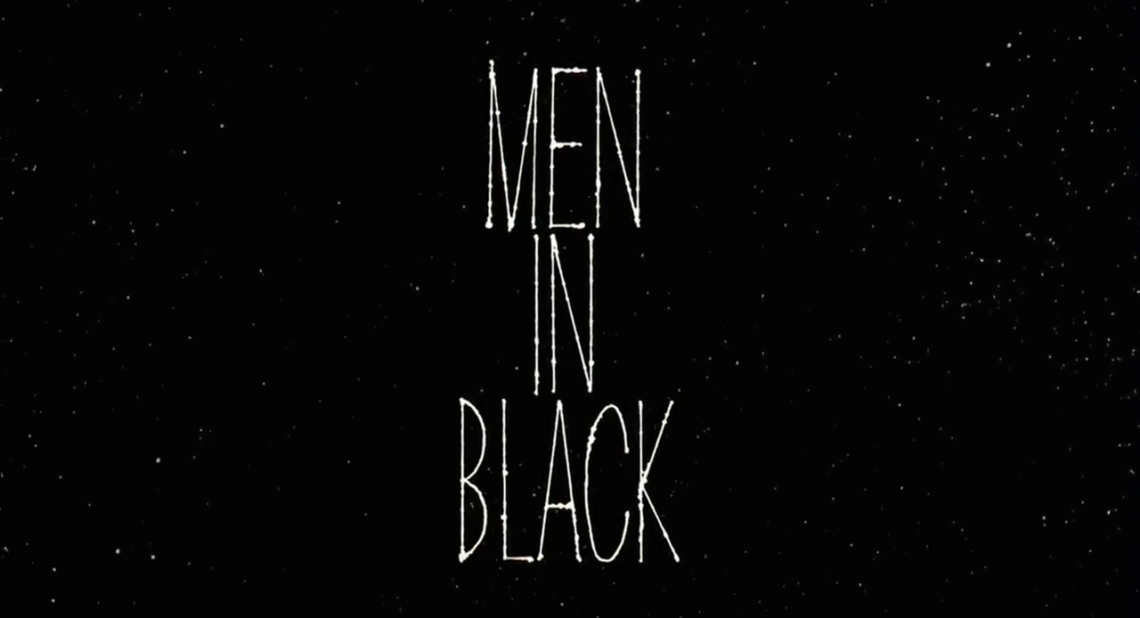-
#539 – Alien Xmas (2020)








Alien Xmas (2020)
Film review #539
Director: Stephen Chiodo
SYNOPSIS: An alien race called the Klepts, who take everything from the planets they visit, have set their sights on Earth next. They send X to the north pole to build an anti-gravity machine that will send everything on earth into space for the Klepts to correct. However, X has landed just in time for Christmas at the north pole, and Santa is busy preparing for the big day…
THOUGHTS/ANALYSIS: Alien Xmas is a 2020 Christmas film. The plot centres around an alien race called the Klepts that plundered their homeworld of all resources, and now move through the galaxy taking everything they can from other planets (get it? Klepts?… Kleptomaniacs?…). The Klepts have set their sights on Earth as their next target, and their leader sends X to earth to plant an anti-gravity device at the North Pole, which will turn off gravity and send everything into space; making it easy for the Klepts to take. Unsurprisingly, the plot of the film has X have a change of heart about giving rather than taking, and the rest of the plot points involve a lot of the typical plots surrounding Santa getting ready for Christmas, A Dad working too hard and neglecting his family, and the true meaning of Christmas. Nothing you haven’t seen before, but this film is really aimed at young kids, so it has to have all the typical Christmas stuff you’ve probably seen a hundred times before, but they haven’t. There isn’t anything really for older viewers to get or enjoy, so it really is just aimed at the young kids. The “crazy” twist (as Santa calls it) that this is a Christmas story that includes aliens doesn’t really make it enough of an interesting twist for those who have seen these films many times before.
With a runtime of forty-four minutes, the film doesn’t fluff itself up with anything it doesn’t need: it tells a Christmas story with it’s own small twist, but doesn’t offer much else. I’m sure young kids will enjoy it because it’s simple enough to follow, is full of colour, and the stop-motion animation has plenty of expression, but again, anyone who isn’t a young kid won’t find anything new or interesting here.
-
#538 – The Christmas Martian (1971)










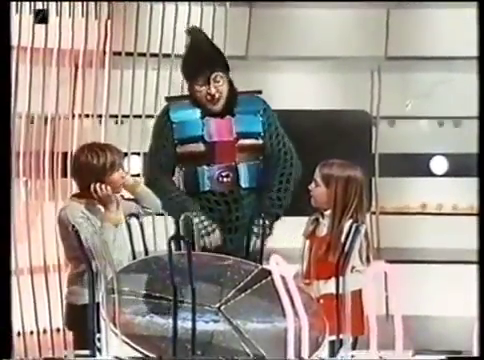

The Christmas Martian (1971)
Film review #538
Director: Bernard Gosselin
SYNOPSIS: Frank and Cathy are two kids out in the snow looking to bring home a Christmas tree, when they stumble upon a spaceship on the ground. Inside, they meet an alien who is trying to repair his spaceship. They decide to have some fun and make some mischief while the people of the town try to hunt down the alien.
THOUGHTS/ANALYSIS: The Christmas Martian is a 1971 Canadian TV movie. Somewhere in a small Canadian town in the wilderness, siblings Frank and Cathy are playing in the wilderness, and have gone to chop down a tree for the family to use as this year’s Christmas tree. I’m not sure in what reality you send out your children who are no older than ten into the woods to chop down a tree and somehow drag it home, but that’s what’s happening I guess. On their wanderings far from civilisation, the two kids find a spaceship parked on the ground. Upon entering, they find an alien who is trying to repair his spaceship, and since the children have not been taught not to approach strangers apparently (especially ones not from this planet), they decide to have fun with the alien causing mischief, stealing vehicles, and other stuff around the town, while the residents try to capture the alien. The film’s plot is nonsensical and barely a plot: it’s just this alien and the kids having a mild amount of fun with “flying” through the air using a large matchstick or something. The kids then “borrow” their uncle’s snowmobile (without permission) and a snowplough later on, which I’m not sure children should be driving. Actually, most of this film is just kids doing stuff that is illegal or just not safe; again, I particularly find the fact that these kids are sent into the wilderness to chop down a tree and drag it home is just bizarre. The running “joke” is that the kid’s mother wonders where the kids are, and the Father’s only reply is that it’s the school break and they’re probably just enjoying themselves.
The whole thing feels like a very cheap TV movie (which it is): the props and sets are fine in some respects, but things like the flying through the air looks pretty cheap and daft. The dubbing is also pretty atrocious, and barely matches the mouth movements. The spaceship has some effort put into it’s design, which is more than can be said for the Martian; who is just wearing a raccoon coat with some sort of net over his head. The only reason you might enjoy this film is if you saw it as a young kid and you have some nostalgia attached to it, but even then it would be a very tenuous link. The main problem in this film is that nothing of consequence ever really happens, and the stuff that does is so unimaginative that it’s hardly going to capture children’s imaginations, let alone anyone else’s. At least in Santa Claus Conquers the Martians there was a plot: an absurd one, but one nevertheless. You don’t need to watch this this Christmas.
-
#537 – National Lampoon’s Men in White (1998)
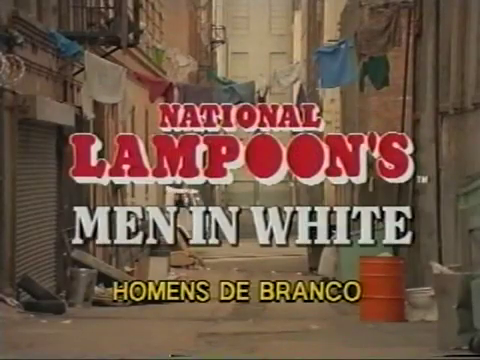


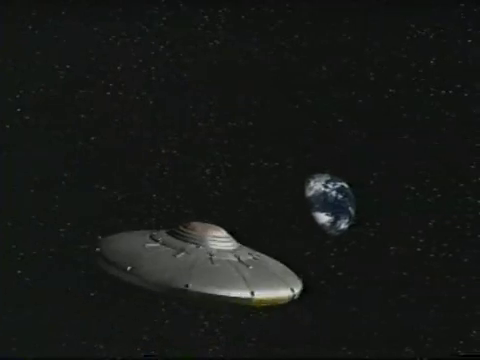






National Lampoon’s Men in White (1998)
Film review #537
Director: Scott P. Levy
SYNOPSIS: Two low-ranking garbage men are abducted by aliens that intend to launch a full-scale invasion of earth. They manage to escape, but are immediately recruited by the government to put a stop to the invasion. However, there are mysterious forces at work that do not want them to succeed…after all, who would put two garbage men in charge of saving the world?
THOUGHTS/ANALYSIS: National Lampoon’s Men in White is a 1998 sci-fi comedy film that is unsurprisingly a parody of the 1997 film Men in Black. The film centres around two garbage men, Roy DuBro and Ed Klingbottom, who are abducted by aliens led by Glaxxon, who intends to invade the Earth with his army. They manage to escape the alien’s clutches, but are almost immediately recruited by the government to stop the invasion by Dr. Strangemeister, who has secretly selected the lowest, most inept government officials to deal with the invasion and fail, since he is secretly working with them. The film is, as the title suggests, a parody of the man in Black film that was released a year earlier, but it is a very loose parody, poking fun at other science-fiction films including Independence Day. The plot is very simple, but it’s just a vehicle for all the gags and comedy, so it’s easy enough to follow. The one thing I’m not sure about is who this film is really aimed at: it has a P.G. rating, and there’s no real adult humour or language, but there’s a fair amount of references that younger viewers probably wouldn’t get. If you’re watching it as a Men in Black parody, there’s enough references throughout the film, and plenty of visual gags that, while nothing special, are still decent. There’s a fair amount of more subtle gags, such as the scenery changing through the President’s windows every scene, which is quite funny, and it reminds me of the Naked Gun films in that no one ever references them. The mix of visual gags, fourth-wall breaking, and slapstick humour is a lot of different techniques that makes threading the film as a whole together problematic; but again, as it’s a comedy-parody film, you can probably just enjoy it for the different gags. Having the National Lampoon’s title attached to it also suggests it would be targeted for an older audience as many of the films are, but I don’t think this is meant to be the case.
The film was produced by Saban International, who most notably do the Power Rangers series, and the aliens and effects definitely have that look and feel about them. Karim Prince, who plays Roy DuBro, also starred in one of the Power Rangers series. There’s a decent mix of CG that doesn’t look too bad for the time, and practical effects that work fairly well. Overall, the film is a mish-mash of different gags that doesn’t really tie together too well, but has a few good jokes (like the scene which makes fun of the Men in Black “neuralyser” that wipes memories). I think the cast is decent enough (apart from the lazy German stereotype of Dr. Strangemeister), but they’re not given too much to do other than delivering bad jokes. It’s not a gripping film, and there’s very little of substance, But I guess for a family film there’s different references and humours for different viewers so I suppose that’s good? I’m not sure anyone who hasn’t watched Men in Black or Independence Day or the like will really appreciate or enjoy it, and it’s references make it a dated film that diminish the humour of the film to modern viewers.
-
#536 – Men in Black: International (2019)











Men in Black: International (2019)
Film review #536
Director: F. Gary Gray
SYNOPSIS: Molly has been obsessed by finding out who the “Men in Black” are ever since she saw them and an alien as a child. She eventually tracks them down as an adult, and convinces them to let her join as a provisional agent. She is sent to London for training where she meets veteran Agent H, and the two inadvertently get caught up in an alien plot that threatens the whole world…
THOUGHTS/ANALYSIS: Men in Black: International is a 2019 sci-fi film and the fourth in the Men in Black franchise. The film focuses mostly on Molly, who when she was a young girl saw an alien in her home, and watched as the men in black came and neuralised her parents. Since then, she has been obsessed with finding out who they are, and about the existence of aliens. Now an adult, she manages to track them down and convince them to let her join. As a probationary agent she is sent to the London branch, where she meets Agent H, a veteran and hero of the branch. the two get involved in an alien plot that threatens the whole Earth, and only they can stop it. The film is a spin-off the the previous trilogy, with none of the characters from them making an appearance apart from one. The plot has most of the typical plot points you would expect from a Men in Black film, with the two agents having to protect a small alien artefact from evil aliens who intend on destroying the world. The plot generally takes a bit of a backseat role compared to the main characters and the general feel of the Men in Black doing their daily jobs, and the comedy that results form it. Unfortunately, this does not feel like a Men in Black film at too many points: the big action scenes are at odds with an agency that seems to be trying to keep their work a secret, the lore seems incompatible with the other films (such as the Eiffel Tower being built for a wormhole or some such, when the first contact with aliens was supposedly in the U.S. in the 60′s. Everything the characters do just doesn’t fit with what we know about the Men in Black. As a typical action film it has a variety of locations and some decent action, but again, just feels out of place. The story feels like a cheap imitation of the other films, and at nearly two hours, it goes on far longer than necessary. having the “international” element doesn’t really add anything new to the franchise, especially when the locations are ones we would typically see in films like this.
The biggest drawback in the film for me is the characters: the previous trilogy had some bumps, but was generally saved the chemistry between it’s two leads, which, while it wasn’t too original to pair a rookie and a veteran, they still generated plenty of strong interactions, comedy and emotions. Here, we get none of that. Molly as Agent M has a mix of personality traits that are jarring and don’t really endear her to her character: I get that she had to be different to a complete “rookie” so as to differentiate herself from Agent J, but her enthusiasm and obsession with the men in Black makes her an annoying character that just feels way out of her depth. Maybe it could have been interesting to contrast her extrovert enthusiasm with the secretive, repressed nature of the Men in Black agency, but I don’t think that has been accomplished here. Agent H is just…bland. I think he’s meant to be written like that partly, as the typical heroic and accomplished agent, but again, that heroic nature just doesn’t work in an agency that is supposed to be discreet and not stand out. The chemistry between them is just non-existent, and nothing ever develops between them. The aliens are altogether forgettable in their design, and supporting characters don’t leave a mark. There’s a fair amount of reviews that say the chemistry between the two is the only redeeming feature of the film, so your mileage may vary on this aspect. The only character that returns is O, the head of MiB, who is more or less the same as she was in Men in Black 3, which is not a bad thing, and we get a brief cameo of the worms and Frank the pug (Who are naughtily given prominent space on the poster despite being in the film for less than thirty seconds), but other than that, it all feels slightly disconnected to the franchise, and any attempt to build something new with the characters just falls flat.
As mentioned, there’s some okay action scenes and a variety of locations, but most of it feels like it doesn’t belong in the Men in Black franchise. I’m also not sure who the film is aimed at, as a lot of the more darker and complex elements have essentially been removed, so it feels less adult, but then again doesn’t seem like a film for younger audiences. The humour is way off the mark: I think I got a slight laugh at one joke: most of it is entirely predictable, and the banter between the two leads, which is supposed to be funny, just comes off as annoying and distracting. The film apparently had a troubled production and underwent numerous re-writes and tinkering, and it definitely shows: the film is all over the place, and not just literally in terms of locations. The film has the return of Danny Elfman for the music, and Steven Spielberg to produce alongside Barry Sonnenfeld (who directed the previous three films), but they just cannot save the script or offer a direction for the franchise. The original film was a tightly packed venture that, while not the best or most original film, was entertaining enough for a summer blockbuster, and built up a nice world for its characters to grow. Every sequel has been trying to match it, and they all fail to do so (Although Men in Black 3 does a good job in it’s own right). The constant recycling of the same plot has failed to give the franchise any room to grow, and while Men in Black: International tries to do some new things, it manages to change too much, so that it doesn’t feel like a Men in Black film for the most part. I appreciate that it it tries to create a new dynamic between the two leads that differentiates them from Agents J and K, but they just don’t come together to make something memorable or interesting (although I appreciate that they didn’t shoehorn in a romance subplot). The story is very thin and as mentioned, recycled, and it just feels like nobody knows what to do with this franchise after the first film over twenty years prior. The humour is predictable and never lands properly, the alien designs are uninspiring, and overall I don’t think there’s anything really interesting or entertaining enough to warrant a watch. I would have to say this is the worse film in the franchise, even below Men in Black 2.
-
#535 – Men in Black 3 (2012)

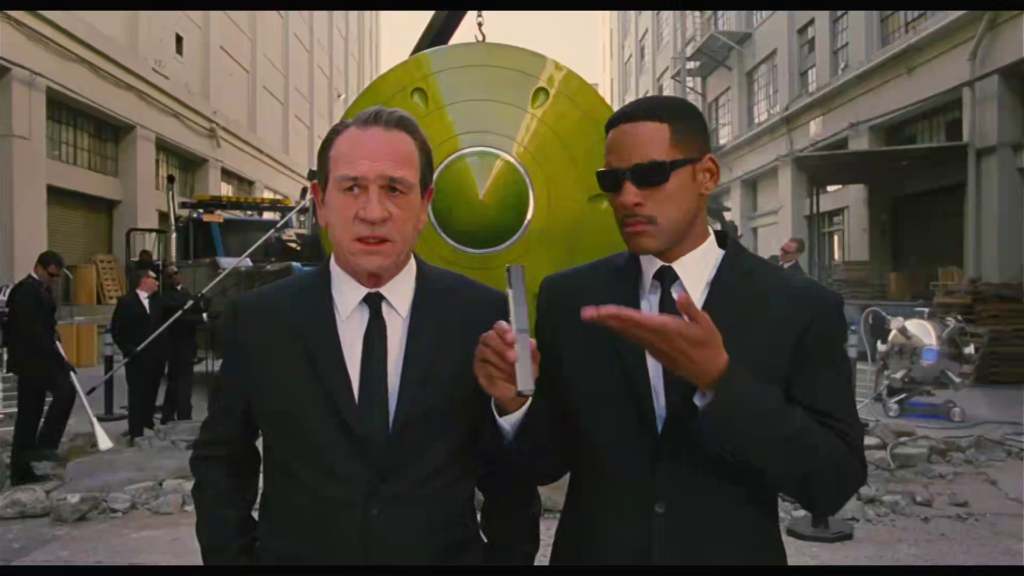








Men in Black 3 (2012)
Film review #535
Director: Barry Sonnenfeld
SYNOPSIS: Agents J and K are investigating an alien incident when they discover one of K’s old enemies, Boris, has escaped from his prison on the moon. J wakes up one morning to find out that K is gone, apparently having forty years ago. It seems Boris has travelled back in time and killed K, so J must also travel back in time to 1969 to prevent K’s death and stop Boris…
THOUGHTS/ANALYSIS: Men in Black 3 is a 2012 sci-fi film and the third in the Men in Black franchise, loosely based on the comics of the same name. The film opens up with a ruthless criminal, Boris (if that is his real name) escaping from his prison on the moon. He heads to earth to take his revenge on the agent who put him there: Agent K. To do so, he travels back in time to kill Agent K, so that his existence for the last 40 years is wiped out. Agent J must himself travel back to 1969 to stop Boris from accomplishing his plan, and save his partner. Bringing in time travel as the core mechanic, the plot has the potential to get very confusing very fast; but the film keeps it mostly simple, so everything stays together well: that’s not to say that there’s no questions surrounding some of the effects of time travel, because there is, but they don’t distract too much from the plot. The enemy this time is Boris, an alien who was imprisoned on the moon because he is such a menace. His whole plot again isn’t too important, and mostly serves as a catalyst to the main element of the film and the previous ones, which is the relationship between agents J and K. On this point, the film again gives us a solid and in-depth exploration of their characters and interactions, and while some of it is re-treading ground from the first two films, there is enough that is new and refreshing to make it worthwhile to sit through. The plot goes at a decent enough pace, and holds back enough mystery and suspense to make a decent payoff at the end, and enough energy along the way to sustain your attention until you get there. The film does gloss over many of the events of the first two films, and there’s some incongruities there, but on the other hand, it also makes this film easily a standalone feature, while still being an extension of what went before. Given the ten-year gap between this film and the previous one, it makes sense that the film can stand on it’s own, as some of it’s viewers will not have watched the first two, or simply forgot the particulars.
While the first film had a rather conventional relationship between J being the rookie, and K being the veteran agent; the second reversed this relationship by having J re-recruit K, which turned J into the veteran, but this reversal didn’t really work for a number of reasons (which I laid out in my review of the film). Men in Black 3 uses the time travel element to again reconfigure their relationship. J and K are essentially equals, but K still refuses to open up about his life. When J travels back in time to 1969, his relationship with young K is a bit more dynamic: J is the veteran, but he’s also a “fish out of water” in 1969, and K is the junior agent, but knows how everything works in that time, so neither of them are the rookie, but neither are they both the vets, so they’re on equal, but even footing, which gives their characters something new and interesting to explore throughout the film. Josh Brolin as young K does a really great job here: he captures Tommy Lee Jones’ K very well, while also putting enough of a spin on it to make it his own. Will Smith is still able to do what he does best getting into slapstick and humourous antics, but his maturity also lets him have some emotional moments too. The supporting characters and villain fill their roles well enough, but they’re nothing too special, but again, the series has always hinged on J and K’s relationship first, and alien invasions and agency bureaucracy second.
The film does a good job brining the 60′s Men in Black to life, with plenty of fun weapon and vehicle designs, and some creative aliens too. While the pop culture references in Men in Black II aged the film and didn’t really work, the time travel element gives the film more free reign to bring 60′s culture to life without aging the film itself. The ending of the film, which isn’t too hard to work out what’s going to happen when it gets underway, is nevertheless emotional and gripping, and feels like a good pay-off. I felt like maybe the film ends a bit too abruptly after though, as it generates all of these emotions, and never works through them to any degree, and so just leaves them hanging in the mind of the viewer with no outlet for them, but I think that others could easily be more satisfied with the ending, and so that point is probably more a matter of opinion than a critique of the film. Overall, Men in Black 3 is definitely an improvement over it’s predecessor, although Men in Black II lowered the bar a fair amount. It’s not a perfect film and still struggles with story outside of it’s core characters, but the film offers a fresh angle on exploring the relationship between the two main characters, while also still being fun and entertaining. Predictable in some parts, but still offers up enough fun and heart to be worth a watch for fans of the franchise, and tight enough to watch as a standalone film if you’ve never seen any of the others.
-
#534 – Men in Black II (2002)
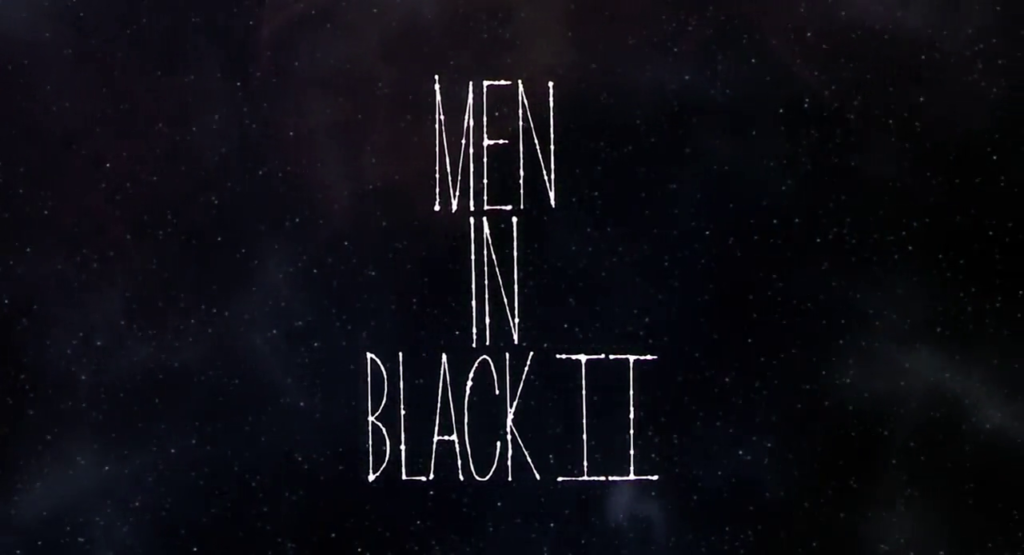







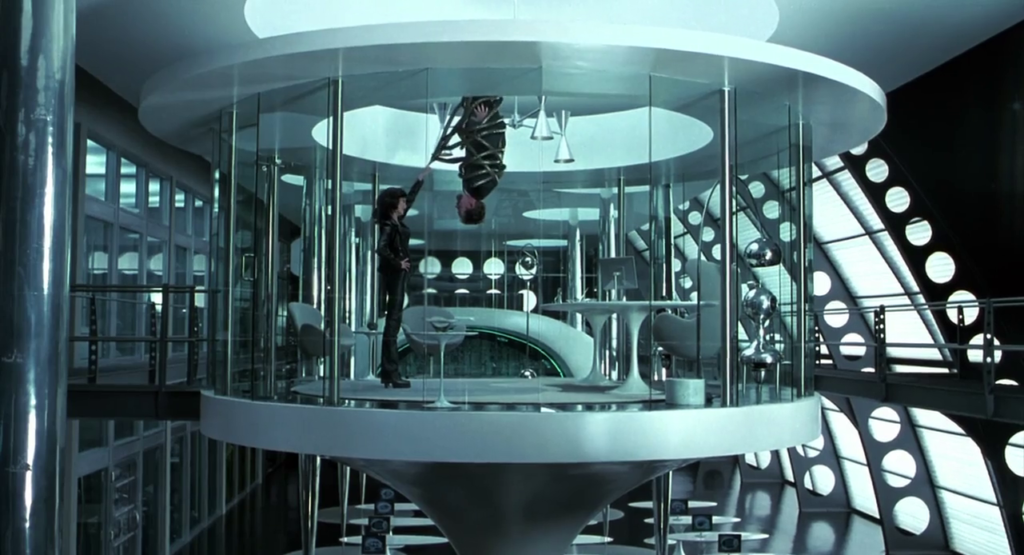
Men in Black II (2002)
Film review #534
Director: Barry Sonnenfeld
SYNOPSIS: Agent J is having trouble keeping an agency partner, as he feels like none of them are cut out for the job. When Serleena, an evil alien, comes to Earth looking for an artefact of immense power called the Light of Zartha, she will stop at nothing to acquire it. Unfortunately, the only person who knows where the light is hidden is Agent K, whose memories Agent J wiped five years ago when he neuralised him. Agent J goes to retrieve Agent K, somehow restore his memories, and hopefully save the world from an alien threat once again…
THOUGHTS/ANALYSIS: Men in Black II is a 2002 sci-fi film and the sequel to the 1997 film Men in Black. The film starts of with Agent J, who five years on from the events of the first film, has gone from a rookie to one of the top agents in the agency. He chases down Jeff, a monster worm who travels through the New York subway. J’s new partner T, seems to be not up to the job, and so J neuralises him and wipes his memory to lead a normal life. Agency leader Z laments J’s constant neuralising of his partners, including L, who became an agent at the end of the first film. Meanwhile, an alien named Serleena lands on Earth looking for the “Light of Zartha,” an energy source of immense power that was supposedly taken off Earth years ago, and she has been destroying planets across the universe looking for it. The only person that knows where it is is Agent K, who was neuralised himself, and so agent J must retrieve him and recover his memories before Serleena destroys everything.
The film’s structure and plot is very similar to the first time…a bit too similar. The film basically just role reverses the two main characters from the first film; with Agent J now being the veteran agent, and now Agent K without his memories is technically the rookie. You can see how this might be an interesting way to mix things up for the sequel and have the characters take on new roles, but it really is just a straight swap between them. Also, Will Smith doesn’t really work as the “straight” guy. Another problem with this is that when Agent K does get his memory back, the roles reverse again, and Agent J suddenly becomes the wisecracking rookie again, undoing all of his character development. This feels very much like a backwards step, although in some senses it is for the best, as the two can get into the roles that work properly for them. Going through all the trouble of getting K’s memories just to have them revert to the status quo is a pretty weak payoff though. The second element of the story concerning the “Light of Zartha” is again just a retread of the first film, in that the agents must find a small artifact that is actually a massive power source. There’s really nothing new that the film offers here.
Will Smith and Tommy Lee Jones are still appealing and entertaining in their roles, and still have great chemistry. The whole role reversal element doesn’t really do anything for their characters though. Frank the Pug takes the role of “rookie” before K returns, but it just doesn’t have the same dynamic, and relies very much on the repeated joke of Frank being a dog and that’s it. The supporting cast of Z and the worms make a return and are fine in their roles, and there’s a strange cameo by Michael Jackson who wants to be “Agent M,” which I’m not really sure what to think of. A lot of the pop culture gags, such as this and Frank’s barking to “Who Let the Dogs Out” definitely ages the film more than anything else. Serleena as a villain is quite boring and underwhelming, both from being very similar to the first film’s villain, and Lara Flynn Boyle’s dry and uninterested delivery just doesn’t work. Johnny Knoxville’s character, serving as Serleena’s henchman, is pretty underwhelming and annoying too: he also just…vanishes near the end of the film, making him seem extremely pointless. The tone of the film is a bit all over the place: the added pop-culture references, as mentioned, definitely age the film, and while some elements of the film feel a bit more geared towards younger audiences, there’s also a few darker elements that are definitely intended for older viewers, so it’s hard to pin down the overall feel of the film. The pop culture references were apparently added in by Barry Fanaro, who revised the first draft of the script, and this is something the original writer, Robert Gordon, avoided doing, which I think he was right about. Fanro did apparently reintroduce Agent K earlier in the film with his revisions, so that’s definitely a plus for him. The director, Barry Sonnenfeld, also took issue with the love story element between Agent J and Laura, because Will Smith doesn’t work as the serious guy (at that time anyway). This very much seems like a film in which no real vision got it’s way, and the conflicts at all these levels compromises in a very safe repeat of the first film.
Overall, Men in Black II definitely has some entertaining elements, and is held together by the main cast and their chemistry. A confusing mix of tone and visions from multiple people involved really hamper the film’s ability to drive the franchise forward, and supported by a weak cast of minor characters and cheap gags, you’ll be left feeling that you haven’t gained anything from watching this film. It’s perhaps worth a watch once, but the first film does everything better.
There’s perhaps one thing about the sequel (controversially) that I will say surpasses the first film though: I prefer the theme “Nod ya Head” to the “Men in Black” song from the first one. I’m sure that will make me some enemies.
-
#533 – Men in Black (1997)
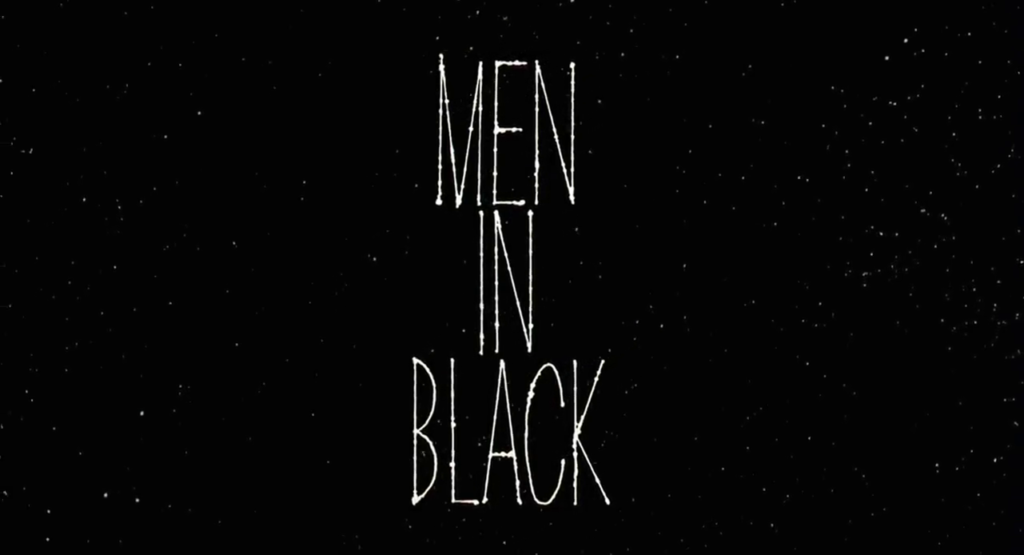




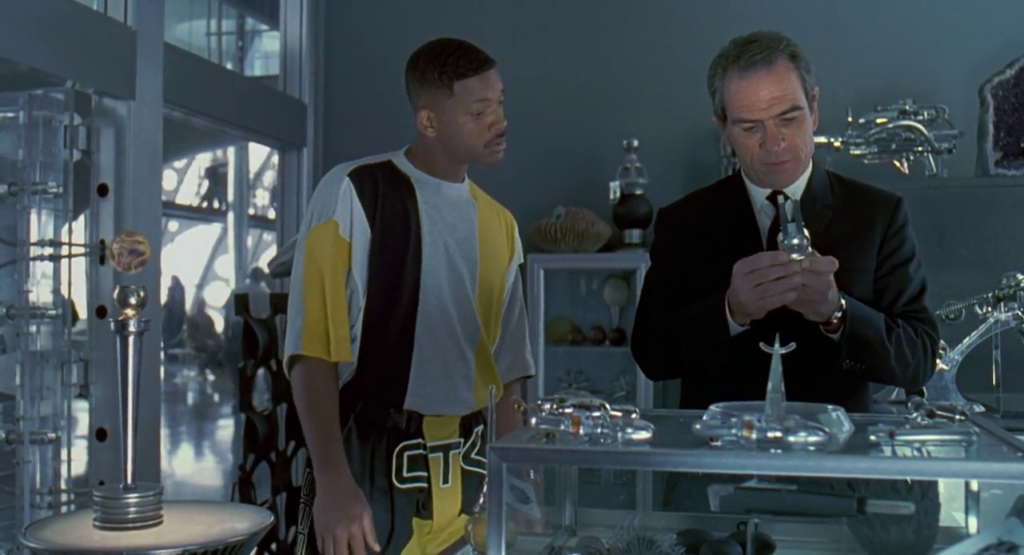




Men in Black (1997)
Film review #533
Director: Barry Sonnenfeld
SYNOPSIS: N.Y.P.D. detective James Edwards chases down a criminal that turns out to be an alien, but no one believes him, until a mysterious man dressed in black turns up, and ultimately wipes his memory. He does however, give him the chance to prove himself, and James becomes Agent J, the newest member of the Men in Black, a secret organisation that monitors and regulates alien activity on Earth. Meanwhile, an intergalactic threat that endangers the Earth emerges, and agents J and K must stop the alien menace and prevent the planet’s destruction.
THOUGHTS/ANALYSIS: Men in Black is a 1997 sci-fi film loosely based on the comic series of the same name. The film centres around a secret organisation (unsurprisingly) called the Men in Black: who monitor and regulate alien activity on Earth, while keeping their existence hidden from the public. NYPD detective James Edwards chases down a suspect which turns out to be an alien in disguise, but no one believes him. That is, until a man dressed in a black suit arrives and confirms his suspicion that aliens are real. The man wipes James’ memory, but gives him the opportunity to join the Men in Black. The best part of the film is definitely between agents J and K, as Will Smith and Tommy Lee Jones fit in to their roles perfectly, and their chemistry is very entertaining. It’s perhaps a bit cliché with J being the streetwise, wisecracking cop, and K being the dry-humoured, grizzled veteran, but they definitely make the roles their own, and together they just work so well. The supporting cast also fit their roles well, and have very specific roles to play. The other plotline other than Agent K training J is one that involves a bug-like alien attempting to find a miniature galaxy that doubles as an energy source, and a diplomatic incident that threatens to end in the earth’s destruction. It’s not as interesting a plot point than J and K’s development, and when the film moves towards the climax, the film does lose focus a bit. Nevertheless, it’s still an entertaining ride, and a comfortable runtime so that it doesn’t overstay it’s welcome.
The film makes considerable effort to create it’s world, and the sets, designs and effects all help build it up into something imaginative and fun. The Men in Black headquarters, and their weapons and gadgets are slick, the alien designs are varied and obviously have had a lot of effort put into them, and although the CG has obviously aged a bit since 1997, it still looks decent and doesn’t disrupt the enjoyment of the film. Add to this the recognisable soundtrack by Danny Elfman, and you have a very competent production all round. Apart from the film losing momentum near the end, Men in Black is a fun, entertaining film that gets the best out of it’s cast and those behind the scenes. It was also successful enough to launch a franchise, including sequels, an animated series, and video games. The film opens up plenty of possibilities to be explored, but never gets too heavy with the lore and exposition, and focuses on being an entertaining film that, while leans a lot on the buddy-cop trope and the rookie partnered with a veteran, it has enough of a twist on it, and amplified by the lead’s chemistry, it feels fresh enough. It still holds up as a good film with enough humour and action to make it worth a watch if you’ve never seen it before.
-
#532 – Lobster Man from Mars (1989)






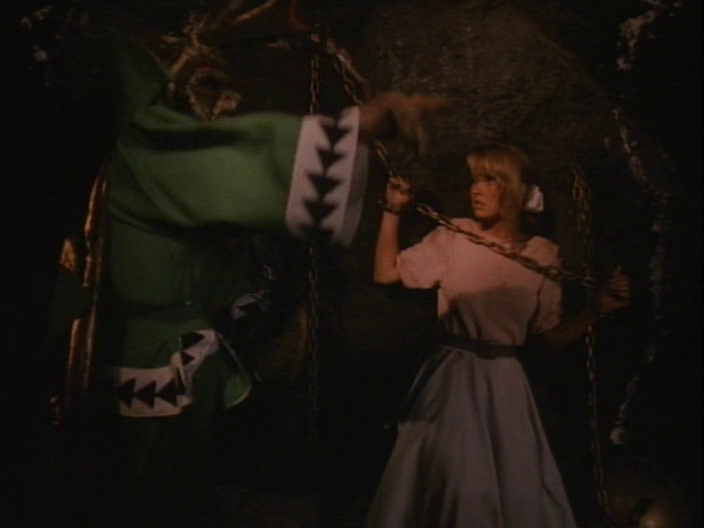



Lobster Man from Mars (1989)
Film review #532
Director: Stanley Sheff
SYNOPSIS: A movie studio executive is plagued by money problems, and requires a tax-write off to keep the IRS away. He decides to produce a film brought in by a young film writer that is utterly absurd: “Lobster Man from Mars…”
THOUGHTS/ANALYSIS: Lobster Man from Mars is a 1989 sci-fi film within a film. Opening up, we see Movie mogul J.P. Sheldrake, who is facing monetary pressure from the usual suspects: his ex-wife, the I.R.S., and so on. He decides he needs to release a movie that flops so badly he can make it a tax write-off and keep those he owes money to at bay. Fortunately, young movie writer/producer Stevie Horowitz walks in with the perfect potential film: Lobster Man from Mars, a film in the style of the old b-movie sci-fi films. The film (as a whole) becomes a film-within-a-film: The movie mogul sits in a theatre to watch the “Lobster Man from Mars” film, and we watch it as well, with a few occasional cutaways to Sheldrake to offer his thoughts. It’s an interesting setup, but was done prior in the 1968 film The Producers to much better effect. We’re also only taken out of the film a few times to see Sheldrake’s thoughts, meaning for the most part the “film in a film” element is irrelevant. With regards to the “Lobster Man from Mars” film itself, it follows a very typical b-movie sci-fi plot which it is aiming to parody: Mars is “leaking air” from it’s atmosphere, and so the ruler of Mars sends the dreaded lobster man and his assistant Mombo, who resembles a gorilla in a space helmet, to go to Earth and steal all it’s air…? Honestly, I’m not sure how they’re going to steal Earth’s air, and how it’s going to help if Mars is “leaking” any air it gets anyway, but regardless, when they arrive on Earth, the killing starts, and anyone who gets in their way gets turned into a pile of bones.
The film mostly plays it straight, with the film-in-a-film just being played without any commentary or over-the-top parody: it could easily pass for an actual b-movie. This is both a core strength and a weakness in the film: the best comedic moments come from the film playing it completely straight without any overt humourous moments, and it is the unexpected moments that provide the best comedy. The drawback to this is that it sometimes plays it too straight, and you forget you’re watching something that is supposed to be funny for fairly long stretches. The humour also feels fairly niche, in the sense that you would have to have actually watched these films originally to really get what it is parodying. Some of the really niche references, such as Colonel Ankrum being a reference to Morris Ankrum, who played similar characters in 1950′s films, is only going to be understood by a fraction of viewers. It definitely gets the b-movie feel right, but in 1989, there was plenty of other parodies of the genre that offered something new and entertaining from an entertainment perspective. This film just feels like it goes through the motions while reminding you it is a parody from time to time. There were a few of these b-movie parodies in the 80′s, but they typically went for a more upfront comedy and absurd premise, such as Killer Klowns from Outer Space. While a plot about Mars leaking air sounds quite silly, it definitely fits the b-movie mold, and would probably have fit right in. Although released in 1989, the film was actually written about ten years earlier, and it definitely feels that way. Lobster Man from Mars does something a little different, but it altogether feels a bit too niche and relies too much on in-jokes to appeal to a more general audience.
-
#531 – The Gingerweed Man (2021)

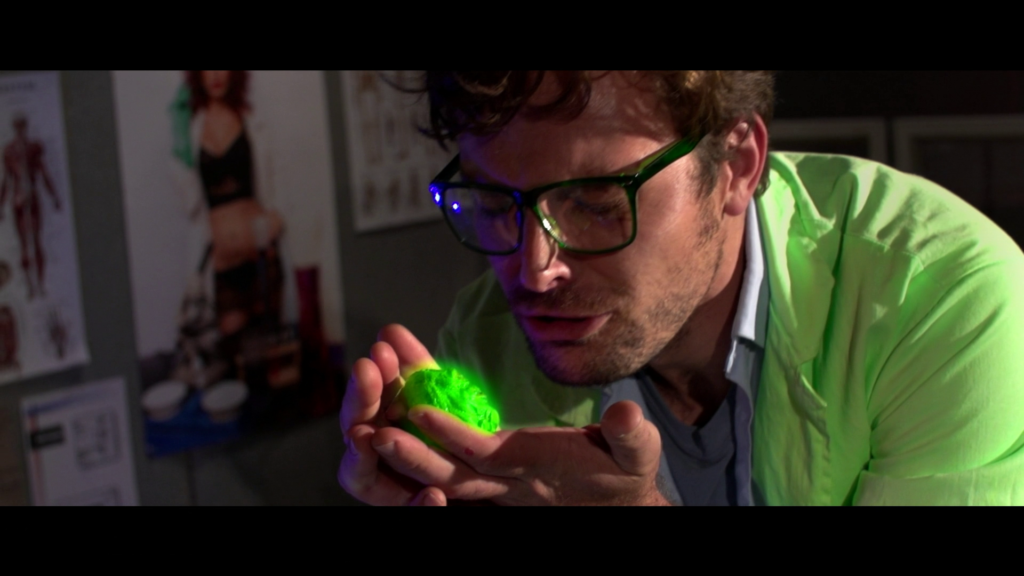








The Gingerweed Man (2021)
Film review #531
Director: Brooks Davis
SYNOPSIS: The Gingerweed man has started a weed delivery service in the city, catering to all sorts of clientele. When he stumbles upon a living, super strain of weed, he finds himself having to prevent it from falling into the wrong hands and being used for evil…
THOUGHTS/ANALYSIS: The Gingerweed Man is a 2021 film and a spin-off of the Evil Bong film franchise. From the opening, we see that the Gingerweed Man has set up a weed delivery service with his partner Barbara, and delivers weed to all the wacky people around town. Meanwhile, a scientist has managed to create a living, super strain of weed powerful enough to save or destroy the world. The evil “Smokeahontas” hunts down the scientist, who manages to hide the super weed and subsequently falls into the hands of the Gingerweed Man. The film’s story is fairly easy to follow, although offers nothing really of any substance. As with the Evil Bong films from which it spawned, the film is only going to be entertaining if you are as high as a kite; the humour is crude most of the time, and apart from that, just doesn’t give anything entertaining to the viewer. Luckily, at just over fifty minutes long (spread over two chapters), it’s fairly quick and harmless, and the short runtime means it doesn’t waste time with extended dialogue or pointless things.
One of the main problems with the film is that the main character, The Gingerweed Man, is not really interesting, and feels like a mish-mash of tropes: he dresses like a stoner, but talks like a posh Englishman with the accent to match. I’m just not sure how to situate the character, so it’s difficult to see where the comedy comes from. Smoke-ahontas as the villain doesn’t seem to really do anything other than to chase other characters, and “Buddy” as the super weed strain…thing is just an annoying high-pitched mascot thing which you will grow tired of quickly.
The Gingerweed Man could have been a chance to try something new after all the Evil Bong movies which are essentially all the same. Of course, being made by Full Moon Entertainment, it was never going to push things in an innovative or original way, but it is at least a bit different (in that it actually has some sort of plot). The film is shot decently, and there’s more than two different sets, so that’s a win. Overall though, I think it’s safe to say that The Gingerweed Man isn’t really anything worthwhile, unless you’re so high you’re detached from reality.
-
#530 – Bruce Gentry (1949)









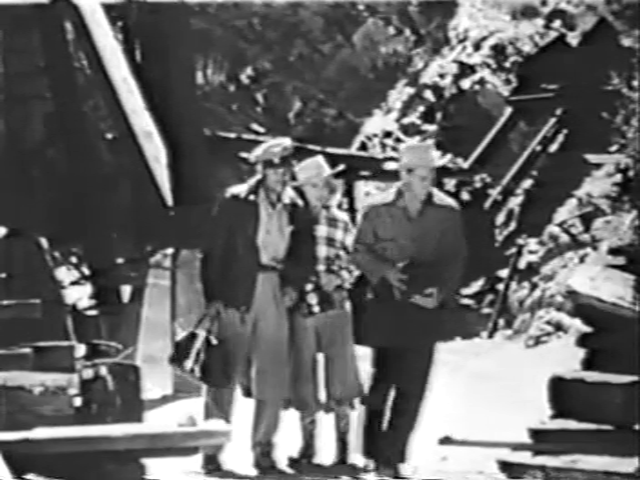
Bruce Gentry (1949)
Film review #530
Directors: Spencer Gordon Bennet, Thomas Carr
SYNOPSIS: Bruce Gentry, a charter pilot, has gone to see his friend is Dr. Benson, but the scientist is kidnapped by a mysterious gang led by a man known only as “The Recorder,” who wants Dr. Benson to work on their “flying disc” machines to unleash an attack on the country. Bruce teams up with Paul Radcliffe, an industrialist, alongside ranchers Juanita and Frank, in order to rescue Dr. Benson and put The Recorder’s gang out of action…
THOUGHTS/ANALYSIS: Bruce Gentry is a 1949 film serial based on the comic strip centred around the character of the same name. The film opens up with Bruce Gentry, a charter pilot, who gets into a fistfight with a gang of henchman less than a minute into the runtime. When Gentry’s friend Dr. Benson is kidnapped by a criminal gang to work on their inventions. Bruce teams up with Paul Radcliffe, an industrialist, and ranchers Juanita and Frank, whose land contains a mine where materials where Plutonite can be found, which the gang need to complete their machines. Together, they all try to rescue Dr. Benson and stop the criminal gang, led by the mysterious “Recorder.” The fifteen part serial has all the components that are very typical of the format, with each chapter revolving around the back-and-forth between the good guys and bad guys as they scheme and counter-scheme one another. It’s formulaic, but no less so than any of the other serials of the time. The use of airplanes as one of the focal points of the serial, and the main character being a pilot was again a popular choice of serials, as they were firmly in the public’s imagination after the second world war, and were seen as heroes. Unfortunately, there’s not much plane action in this; merely travelling from one destination to another, and usually not making it, as Bruce typically has to jump out of the plane at the last second to avoid being killed in typical cliffhanger fashion. There’s no dog fights or combat in the skies, which is something other serials do, so it is going to pale in comparison to others, and it feels like more could have been done instead of the forgettable schemes we get. The plot barely moves forward at any point, and is stuck at the initial stalemate between the heroes and villains until the final chapter.
The cast of characters is pretty bland: Bruce Gentry is a typical male lead (as with nearly all of these serials), but he doesn’t have anything special or interesting to set him apart: he just flies a plane occasionally. The rest of the characters are also unimportant: Paul Radcliffe, who hires Bruce to investigate the criminal gang, wants the secret of the flying disc’s that the gang uses for himself, but keeps that a secret. This could have led to an interesting side story, but it’s never really followed up. There’s Juanita, the one female character (apart from Paul’s secretary) who has some fight in her, but usually just falls into the role of being kidnapped every other chapter. Frank is completely ineffectual, and just serves as another pair of hands, and the henchmen are completely unremarkable. The Recorder, the mysterious villain who leads the criminal gang, is only heard through voice recordings (hence the name I guess), and while his identity is kept secret throughout the serial, his eventual reveal comes long past the point of being invested in this serial.
As mentioned, the serial does little to try anything new, and the lack of action that isn’t just fistfights makes everything very predictable and dull. One noteworthy element is that this serial is the first time a “flying saucer” was featured on screen, with the criminal gang’s “flying discs” being their main weapon. They are mostly seen as a traditionally animated object flying towards the screen, which does look a bit out of place, and could probably achieved without resorting to animation and creating something so distractingly different to the rest of the serial. This technique was done in other serials, most notable in the Superman serials, but this was typically for when Superman had to fly, which would have been difficult to film in such low budget, low-tech conditions. In Bruce Gentry, I’m sure they could have just used a model to the same effect. Directed by Spencer Gordon Bennet, who directed by so many similar serials, Bruce Gentry has all the pieces of a typical serial, but fails to offer anything in terms of an exciting plot, interesting characters, or unique sci-fi premises. I’d rank it below average, but definitely not the worst of the movie serials (only because there are some really bad ones).




